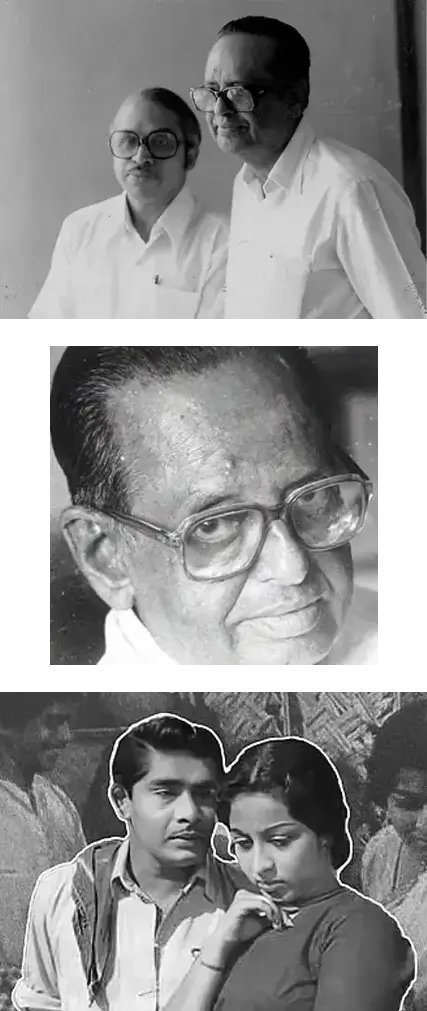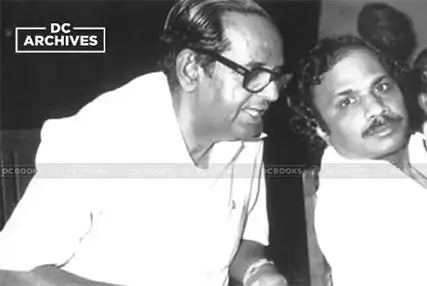DOMINIC CHAKCO KIZHAKEMURI
(12th January 1914 - 26th January 1999)
Father of the paperback revolution in India

Dominic Chacko Kizhakemuri was born on 12th January 1914, the eldest son of Munjanattu Eliyamma and Kizhakkemuri Tharavattil Chacko in Parathode, near Kanjirapally. In 1930, he cleared the Vernacular Secondary School Leaving Certificate Examination and began working as a teacher at the Middle School in Kanjirapally. Soon, he passed the TTC Examination too. Having served as a teacher for twelve years by then, the young Dominic Chacko was fondly referred to as “Kochu Saar” in Malayalam ( ‘‘Little sir’’), being the youngest member of the faculty. Swept along by the fervour of India’s struggle for independence from colonial rule, he joined the Indian National Congress. As was often the case, the youthful combination of a teacher and a freedom activist resulted in an admiration and appreciation of the great authors of the time. Consequentially, this became the impetus behind the establishment of the Sahridaya Granthasala, a library in Kanjirapally where Dominc Chacko functioned as a member of the managing committee. In 1943, he assumed the mantle of editor of the annual magazine published by the Granthshala. Two years later, he resigned from the post of a school teacher and began farming. It was then that Ponkunnam Varkey, a friend, invited him as a partner in opening the National Book Stall in Kottayam.
Despite numerous hurdles and setbacks at the outset, the founding partners persevered through changes in the management team and the surrounding social turbulence as a result of the independence movement, eventually achieving a modicum of success. This was a period in time when the colonial administration was imprisoning political activists and literary stalwarts. Dominic Chacko was incarcerated as well. On his release, he set about reviving the then floundering NBS, raising funds through commercial moneylenders at a steep rate of interest. Nevertheless NBS published fifteen books that year and within a couple of years had turned profitable.
DC. Kizhakemuri was one of the founders of the Sahitya Pravartha Co-operative Society, a collective of writers and he became its general manager. In 1949, SPCS merged with NBS. For the first time in Kerala, a publishing house recruited people specifically to market its books. Sometime in 1950, the founders learnt that the Kerala State Government was inviting manuscripts to produce textbooks for supply to educational institutions functioning under the government’s education department. With the promise of a substantial purchase and recurring profits accruing to the co-operative every year, DC (as he was popularly referred to) negotiated with the chief minister and education minister, requesting them to accept the SPCS textbook proposal in lieu of the land that the government had offered him for his role as a freedom fighter, pointing out how with the proceeds of the sale of the textbook would sustain the writers in the collective.Thus, the textbook featuring a story titled ‘Balachandran’ was accepted as part of the Forum II syllabus. Around 50,000 copies were sold for 8 annas each and SPCS thrived, becoming a profitable organisation that would subsequently go on to print hundreds of titles every year. A noteworthy milestone in the history of the SPCS then was the publication of ‘Mooladhanam’, a compendium of translations in three volumes of Karl Marx’s writing, authored by thirty eminent scholars including E.M.S. Namboothirippad, a doyen of the Communist movement in Kerala. DC Kizhakemuri’s pioneering vision gradually transformed SPCS into an eminently successful co-operative literary society between 1960 and 1975, at times publishing and marketing a book a day. This model was soon adopted in other parts of India and numerous similar co-operative ventures were formed in support of authors.


Also regarded as the ‘The father of the paperback revolution in India’, DC Kizhakemuri published ‘Chemeen’, a popular classic in Malayalam. The first paperback published in India, DC innovated with Calico binding and inexpensive paper stock, retailing through NBS at an eminently affordable price which gained the edition substantial traction among lovers of good literature. SPCS produced a thousand copies of the book. The pre-launch marketing of the book was also innovative for its time. Pre-publishing advertisements were strategically placed to help spread awareness of the book. By the time the fifth edition of the book was published, DC continued to experiment with the paperback form, eschewing Calico binding this time and including a flapped cover. In six years, eleven editions of the book were published and around 11000 books were sold, when DC persuaded Thakazhi on the necessity of taking a step forward and publish 10,000 copies per edition, at the rate of Rs.1.50/- for each printed copy. The royalty paid to the author would pare down from 30% to 10% consequentially, but he would be compensated by increased sales. The twelfth edition of ‘Chemeen’ was published in January 1963. Buoyed by its resounding success once again, the thirteenth edition was published in 1966.
DC Kizhakemuri strongly held a conviction about the benefits of a broad based access to knowledge for all sections of society, believing as he did that this access provided a vital leverage for social uplift. “Books should be within everyone’s reach, not just a privileged few,” he once said. A couple of initiatives that DC undertook exemplify the visionary and passionate lover of books that he was. In 1952, books were exempted from the payment of sales tax in the state of Kerala, in no small part due to DC lobbying with the government, pointing to the socially empowering roles that books played. Emulating Kerala, the then Indian prime minister Jawaharlal Nehru subsequently ensured that a similar initiative was successfully replicated across all the states in India.
In 1989, spearheading a movement that advocated mass literacy, DC Kizhakemuri played a prominent role in ensuring that Kottayam was eventually declared 100 percent literate in 1989, becoming India’s first entirely literate town. Another pioneering innovative initiative that he implemented to popularise the reading habit was the conduct of a lottery to finance the expansion of the Kottayam Public Library, functioning as its secretary between 1962 and 74. Impressed by the social acceptance and success of the first lottery, the government granted permission for another scheme to be launched, this time to expand the range of books in the library. DC commissioned lottery agents at 10% and in a month the lottery had brought in close to five lakh rupees. Soon, the state government then, following the trail of success, launched its own lottery scheme with the tickets being printed on a machine that DC Kizhakemuri donated to the government.


D C Kizhakemuri assumed responsibilities as the General Manager of NBS between 1965 and 1973 before retiring in 1974. He was sixty years old then. DC now faced a conundrum, to shift his attention to a fish-breeding business at Kanjirapally or continue with book publishing, which hitherto had been his passion for three decades. The legendary Malayalam author and his friend Thakazhi helped him take a firm decision at this juncture, advising him to continue with publishing and experiment with the ideas that he had been unable to implement at SPCS. And so, in 1974 DC Kizhakemuri launched DC Books, buying the shares held by his partners in NBS and incorporating the two entities. A printing machine was purchased with his retirement benefits from SPCS, inks and paper were purchased utilising commercial funding. The first book that DC decided to publish was ‘Malayalashaileenikhandu’, a dictionary authored by T. Ramalingam Pillai. With the immediate commercial success of the book DC was able to clear the liabilities incurred until then. DC Books published twelve titles in its first year of operation.
DC Kizhakemuri brought a transformational vision to the publishing of books, not just in content but also in the aesthetics of a book. In his mind’s eye, a book transformed into a beauteous form of knowledge. Book covers underwent a radical transformation with professional designers and illustrators weaving visual spells, collaborating with lexicographers, editors and translators. Books were wrapped in exquisite binding and imprinted with top quality printing ink on the finest paper stocks.
A multi-faceted individual DC Kizhakemuri was at once an author, entrepreneur, freedom fighter and social activist. Perhaps his oeuvre as an author has not yet received its rightful place in the limelight, unlike his stellar contributions as a social entrepreneur and activist. As an author D.C.Kizhakemuri was prolific, writing periodic columns for vernacular journals and publishing an anthology of his satirical political essays. His literary is style is spare and bereft of ostentation, embellished with generous servings of humour and thematic preoccupations shaped by incisive social commentary, narratives rooted in the daily lives of common people in Kerala.
Being a cultural and social visionary, DC.Kizhakemuri was closely associated with many of India’s national leaders, being feted by the former President of India, Mr. Sanjeeva Reddy for the publication of ‘Samkshepavedarth’, an excellent edition of the first book printed in Malayalam. When D C Kizhakkemuri passed away on the 26th January 1999, the then prime minister of India, Mr. A B Vajpayee, eulogised him as “ The man who brought the publishing industry closer to the masses”. The government of India honoured DC Kizhakemuri with the Padma Bhushan in 1999.
*(Source material courtesy Nithya Mariam John)
